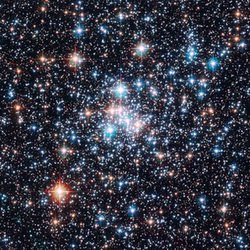
Star clusters in small magellanic cloud. Image credit: ESA/NASA. Click to enlarge
The Hubble Space Telescope has captured these stunning images of open star clusters NGC 265 and NGC 290 in the Small Magellanic Cloud. The two clusters are about 200,000 light years away, and are roughly 65 light-years across. Clusters like this contain young stars roughly the same age, and born from the same cloud of interstellar gas. These clusters will eventually be broken apart by the gravity of other stars, gas clouds and clusters.
NASA’s Hubble Space Telescope has captured the most detailed images to date of the open star clusters NGC 265 and NGC 290 in the Small Magellanic Cloud – two sparkling sets of gemstones in the southern sky.
These images, taken with Hubble’s Advanced Camera for Surveys, show a myriad of stars in crystal clear detail. The brilliant open star clusters are located about 200,000 light-years away and are roughly 65 light-years across.
Star clusters can be held together tightly by gravity, as is the case with densely packed crowds of hundreds of thousands of stars, called globular clusters. Or, they can be more loosely bound, irregularly shaped groupings of up to several thousands of stars, like the open clusters shown in this image.
The stars in these open clusters are all relatively young and were born from the same cloud of interstellar gas. Just as old school-friends drift apart after graduation, the stars in an open cluster will only remain together for a limited time and gradually disperse into space, pulled away by the gravitational tugs of other passing clusters and clouds of gas. Most open clusters dissolve within a few hundred million years, whereas the more tightly bound globular clusters can exist for many billions of years.
Open star clusters make excellent astronomical laboratories. The stars may have different masses, but all are at about the same distance, move in the same general direction, and have approximately the same age and chemical composition. They can be studied and compared to find out more about stellar evolution, the ages of such clusters, and much more.
The Small Magellanic Cloud, which hosts the two star clusters, is one of the small satellite galaxies of the Milky Way. It can be seen with the unaided eye as a hazy patch in the constellation Tucana (the Toucan) in the Southern Hemisphere. The Small Magellanic Cloud is rich in gas nebulae and star clusters. It is most likely that this irregular galaxy has been disrupted through repeated interactions with the Milky Way, resulting in the vigorous star-forming activity seen throughout the cloud. NGC 265 and NGC 290 may very well owe their existence to these close encounters with the Milky Way.
The images were taken in October and November 2004 through F435W, F555W, and F814W filters (shown in blue, green, and red, respectively).
Original Source: HubbleSite News Release

When you distill the many words down, there is surprisingly little information. Other sites have even less, including Hubble itself.